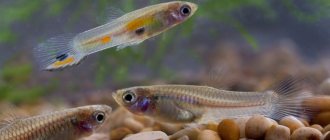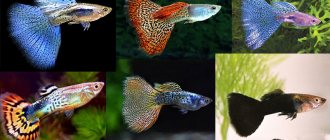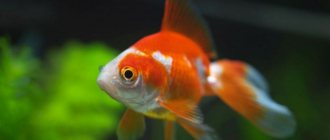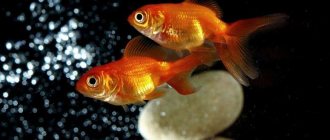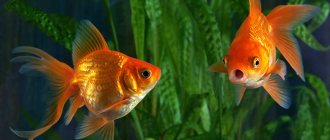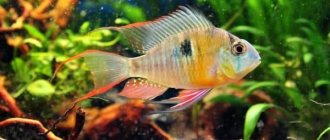These fish are sensitive to water purity, slow and phlegmatic, and love to eat aquarium algae. They are called aquarium centenarians because they live up to 15 years. We are talking about the Butterfly Telescope. How to properly keep this species of inhabitants in a fish house? What to feed and how to breed?
The Butterfly telescope has an egg-shaped body. It is short. The caudal fin is forked, and its shape resembles the wings of a butterfly. Hence the name of the fish. The dorsal fin is high and vertical. The main feature of the Telescope is its large and protruding eyes. They are cylindrical, round, cone-shaped. The eyes protrude 2 centimeters above the body line. The colors of Butterfly Telescopes are varied: red and gray, calico and black. The latter is valued more than the others. The scales of the fish have no shine. The length of these aquarium inhabitants is up to 15 cm. Rare specimens reach 25 cm.
Appearance of a butterfly telescope
A mature telescope has convex eyes; their shape can have various variations: cone-shaped, cylindrical, spherical. In fry up to four months, the eyes do not stand out at all. By the time the fish is six months old, the diameter of the eyeballs can reach up to 5 cm. The eyes are directed in opposite directions and slightly shifted forward, the axis of each eye is perpendicular to the surface of the head.
The body of the butterfly has a round shape; when you look at the fish, you get the impression that it is slightly swollen. In general, representatives of this species grow up to 25 cm, at home - up to 12 cm.
Telescopes are divided into scaled and scaleless. In turn, the first of them are further divided into plain and calico. Unlike scaly individuals, scaleless ones lack a metallic sheen.
The tail of adult individuals exceeds the size of their body and is forked. Thanks to crossbreeding of breeds, the rear fin of the telescope can be shaped like a butterfly or a flowing veil.
The predominant color of the butterfly telescope is pink and white. Solid colored butterflies are usually white or red with a scarlet tint. There are also black telescopes. They do not develop this color immediately, only as they grow older. The color of the fins can be white or additionally have intense black or red splashes.
With proper care, short-bodied veiltails live up to 15 years, long-bodied ones - up to 30.
Popular types
Thanks to the painstaking work of breeders, several varieties of telescopes were developed, which differ from each other in: scales, color, fins, degree and shape of bulging eyes. Despite the fact that there are quite a lot of types of telescopes, they all have one similarity - these are large bulging eyes on the sides of the head.
The most popular representatives are:
gold fish
The body has an orange color and a metallic sheen;
Panda
On the body the pattern alternates with black and white velvety stripes and has a scaleless body;
Black Moor
It has a rich charcoal color, the tail is small, the remaining fins are also small and neat;
Calico butterfly
A beautiful and unpretentious fish, it has a luxurious tail, shaped like the wings of a butterfly, its color can be gold, black and white.
Behavior and Compatibility
Butterflytails are schooling fish, which are recommended to be kept in groups of 4 or more individuals. They have a calm temperament and are quite clumsy, which is why, being adjacent to more active individuals, they may not have time to feed. It is acceptable for telescopes to live together with calm representatives of other species.
It is contraindicated to combine adult butterflies with fry or other small fish - the small fish will certainly be swallowed. You should not add other individuals prone to aggressive behavior to goldfish - the telescopes will gnaw off their fins.
Compatibility with other fish
The telescope is almost always kept in a species aquarium, since it does not get along with other representatives of the underwater fauna. Mostly other breeds of goldfish such as oranda, veiltail, shubunkin, riukin, water eye, ranchu, etc. are suitable as neighbors.
Also, these big-eyed animals can get along with ancistrus, since catfish do not show aggression towards their neighbors, are more nocturnal and stay near the bottom in thickets of snags. As a rule, they do not touch goldfish. The only exceptions are when the descendants of the “crucian carp” swim into a territory other than theirs and try to take food from the catfish. But even in this case, he would rather scare off his enemy than injure him.
The telescope is almost always kept in a species aquarium, since it does not get along with other representatives of the underwater fauna.
Aquarium volume and fish stocking density
When choosing an aquarium, first of all, you should rely on its length: for a group of 3–4 individuals, a container of 70 cm is suitable. In this case, the volume should be 15–25 liters per one veiltail. The optimal container for one butterfly is 30 liters, with the possibility of increasing the tank volume for each additional fish by 10 liters. The aquarium must be equipped with a lid.
When the volume of liquid in the holding container increases, a slight excess in the stocking density of individuals is allowed. However, don’t get carried away: these representatives of short-bodied fish, unlike long-bodied ones, have a greater need for space.
In aquarium and pond farming[edit | edit code]
The fish is suitable for keeping in a cold-water aquarium with plenty of space for free swimming. Beautiful in greenhouses. Due to the endurance of the breed, it can be kept in a decorative pond outside. Prefers a community of its own kind, bright light and plenty of free space. Effective filtration and regular water changes. When designing a reservoir, it is recommended to use loose fine-grained soil, stones, driftwood, live or plastic plants, including floating ones. When decorating, it is necessary to avoid the use of objects with sharp edges and edges, for which veil varieties of fish can be injured during swimming and, if caught, tear off the fins.
Aquarium decoration
Requirements for plants:
- Hard leaves (veiltails will quickly eat up delicate algae);
- Strong root system;
- Does not require heating of water;
- It is better to plant in pots (there is a high probability that they will be dug out of the ground);
- When planting in the ground, it is necessary to reliably protect the root system with large pebbles.
Priming:
- Sand - coarse;
- Pebbles - 3–5 mm in diameter;
- Rounded (without pointed edges);
- The best option: put pebbles on the bottom and give relief with smooth volumetric stones.
To decorate an aquarium, it is not recommended to use driftwood, grottoes and other decorations of this kind. When decorating an aquarium, remember: goldfish are clumsy and can injure their eyes or fins on the sharp edges of the decorations. In addition, cluttering the aquarium will make it difficult for the fish to move.
Care and maintenance
To keep a water dragon you need a spacious rectangular aquarium. A round aquarium, due to improper refraction of light, will worsen the already poor vision of the fish and lead to blindness. Fish have a good appetite, so due to the large amount of waste, a powerful external filter will be needed. To saturate the water with oxygen, you should install a compressor in the aquarium.
Water parameters per individual:
| Volume | Temperature, C° | Acidity, pH | Hardness, рGH |
| 50 liters | 17-23 | 6,5-8 | 6-18 |
It is important to ensure safety and comfortable conditions for aquatic inhabitants. Pebbles or coarse sand are placed on the bottom. Often individuals, rummaging in the sand, swallow its particles. The small ones are spit out, and the large ones are choked. Help from the aquarist must occur immediately, otherwise the fish will suffocate.
Laconic design is what you need for telescopes! The fewer decorative items, the safer!
For decoration you need to choose smooth rocks and grottoes without sharp edges. This reduces the likelihood of damage to bulging eyes.
Every week the water is changed by 20%. Proper maintenance conditions significantly extend the life of a water dragon.
Since fish are active diggers in search of food, it is better not to plant living plants, as very soon they will not have roots.
Use heaters to heat water. Sudden temperature fluctuations can be detrimental to telescopes.
You can feed all types of live and dry food. Excluding their combination in one feeding.
Water
The telescope butterfly, unlike other types of goldfish, is more heat-loving, however, it does not tolerate overheating well. The recommended temperature for such fish is 21–23 °C. A limit of 18–28 °C is acceptable, but not very desirable, but it is important to ensure that the changes are not sharp.
The butterfly tail is quite picky about water, so it is necessary to change up to 30% of the volume of liquid in the aquarium weekly. In water with poor quality or excess acidity, fish experience fraying and the appearance of a whitish coating on the fins. Such symptoms indicate the need for more frequent water renewal. 1–2 hours after changing the liquid in the aquarium, the natural appearance of the veil tails is completely restored.
Water chemistry:
- Hardness - 8–20;
- Acidity - 6–8;
- Adding salt will improve the well-being of the fish - 5–7 g/l (salinity 12–15%).
Jikin - goldfish
Jikin goldfish photo
Jikin is the rarest type of goldfish. It is practically not found in amateur aquarium keeping, since since 1958 its distribution has been limited due to its inclusion in the list of protected species in Aichi Prefecture (Japan). The history of the breed begins in the 17th century, when the Ryukin was bred from an ordinary goldfish, and the Jikin became a side branch of selection; for hundreds of years, its development was carried out in the region now known as Nagoya Prefecture.
Jikin goldfish photo
Due to the common origin, this breeding form has common features with Ryukin. The body shape is round with a large belly and short. The caudal fin is divided into four parts, the upper two are raised. If you look at the fish from behind, the tail takes on the shape of the letter “X”. For this feature in Europe and America, Jikin is sometimes called “Peacock’s tail”.
Jikin goldfish photo
The main feature of the jikin is its body coloring. The white body has bright orange patches located in strictly defined places: the mouth, gill covers, ventral, dorsal and anal fins, the area near the anal fin, tail. This coloring is considered a standard color, but practically never occurs, so it is achieved artificially. Breeders use several methods: injecting dye where there is not enough color, and removing pigment where it is excess. It is worth noting that in Western countries such methods are condemned and are subject to local animal protection laws, since these manipulations not only entail stress, but also directly affect the health and life expectancy of the animal.
Adviсe
- Veiltails should not be overfed, because goldfish are voracious and prone to obesity, which can lead to infertility;
- The diet should contain more carbohydrates than proteins (there are specialized foods that, among other things, increase the richness of pigmentation);
- To reduce the craving for eating aquarium algae, it is necessary to increase the content of plant foods in the diet (for example, feed with riccia);
- Dry food swells and in order for the butterfly not to have problems with digestion, it should be soaked before feeding: flakes - 10 seconds, granules - up to 30 seconds;
- A symptom of systematic overeating is turning over with your belly up after eating.
Goldfish do not have a stomach, only long intestines. Constant overeating can lead to the death of the fish, because without having time to pass through the intestines, the food begins to decompose. This puts unnecessary pressure on the swim bladder and can also cause constipation. If this behavior has been noticed recently, then you are still able to save the telescope’s life. To do this, it is worth keeping him on a starvation diet for some time.
Feeding
Diet for adults: 2 times a day (morning and evening). Pour the food into the feeder so that it does not immediately sink to the bottom. At the same time, calculate the amount of food so that it is eaten in a maximum of 5 minutes. The daily diet should not exceed 3% of fish weight. Remove any leftover food to prevent the water from spoiling.
Tips for feeding the telescope butterfly:
Veiltails should not be overfed. The diet should contain more carbohydrates than proteins. To prevent fish from eating aquarium plants, increase the content of plant food in their food. Before feeding, soak the food: flakes for 10 seconds, granules for up to 30 seconds. If a fish swims with its belly up after eating, this indicates that it is systematically overeating.
We will talk about the health and breeding of these fish in the next article. And we would like to remind you that you can purchase everything you need to keep fish in the Zoogalereya chain stores.
Breeding
Gender
In the butterfly tail, it is quite difficult to distinguish between female and male individuals; this requires experience. Males have tiny serrations on their pectoral fins, and semolina-sized bumps appear on their gills before the breeding season. In females, eggs ripen in the abdomen during this period, causing it to swell significantly. When viewed from above, one can observe a curvature of the body, which often remains after the mark.
Puberty and preparation for spawning
Telescopes mature by the second year of life. The spawning season lasts from April to May. In order to avoid premature fertilization, it is undesirable to keep male and female individuals together. Otherwise, you will have difficulties with fry that need live food, which will be extremely difficult to obtain.
Filled with eggs and released females must be kept in an algae-free aquarium. Friction against plants can provoke premature spawning. It is also possible to slow down spawning by lowering the temperature.
Already in March - April, you can notice that males hover around females, trying to stay close to their ovipositor. This behavior is a determining factor in the sexual maturity and readiness of individuals to conceive. However, a more convenient time for spawning is May - June.
When preparing butterflies for conceiving offspring, you need to pay special attention to their diet. Feed tightly, but avoid overeating. The menu should consist of live food: bloodworms, earthworms, daphnia, chopped meat is allowed.
Telescope fish: maintenance, breeding, compatibility, photo, video
The telescope fish is a popular aquarium pet with a distinctive structure. Considered a type of goldfish, it is distinguished by the presence of bulging eyes located on the sides of the head. The aquarium telescope fish is able to live at low temperatures, which makes it an unpretentious pet, available in the aquariums of collectors and hobbyists.
Where did the telescope come from?
In natural habitats, telescope fish are not found at all. Gold rocks were created artificially. The predecessor is wild crucian carp. This is a common aquatic animal that inhabits bodies of water with standing water - ponds, lakes, canals. It feeds on plant foods, insects and fry. The birthplace of the telescope is China, in the mid-16th century. it reached Japan and then Europe. Most of the varieties of this breed were bred in the East. Since then, the standards have not changed.
Telescope fish - contents
Keeping these fish is very, very troublesome, because these fish are especially whimsical.
In particular, they are very picky about the oxygen content in water. It is best to take a large aquarium for such fish - from forty liters per pair of fish, and in the aquarium with these fish there should be no stones or decorations with sharp corners
. In general, anything spicy is strictly prohibited because these fish can get hurt very easily. The temperature should vary from twelve to thirty degrees with hardness up to 20, pH from six and a half to eight.
Telescopes are peaceful fish, so they can very easily be kept in the vicinity of other peaceful fish. But be careful, because any, even insignificant, aggressive fish can very easily injure the eyes of telescopes.
GOLDFISH CARE CONTENTS BREEDING COMPATIBILITY DESCRIPTION.
The best option for keeping telescopes is away from all other fish and in a spacious aquarium in which the water is very rich in oxygen. It will also be good to keep telescopes together with veiltail goldfish.
The aquarium in which you will keep telescopes must have excellent air flow and excellent water filtration. It would also be a good idea to triple the aeration of the water.
Telescopes are not very good friends with plants that are poorly rooted, because telescopes simply pull them out. They bite plants with tender leaves.
As for the parameters, they should be as follows:
- Size and shape of the container . Goldfish require a lot of oxygen and produce a fair amount of waste. Therefore, with a large surface area of water, the risks of oxygen deficiency are reduced. And as you know, an elongated tank has a larger surface area than a tall one with the same volume. If the container is round, it is better to fill it halfway rather than to the brim. A 90-150 liter aquarium is suitable for one telescope. If the number of inhabitants increases, the space should be calculated in such a way that there is at least 40 additional liters for each fish. Beginners should immediately purchase a large tank or, if necessary, prepare to purchase more spacious “apartments” for their charges. In a cramped container, the water will quickly become polluted, the fish may not have enough oxygen, and they will begin to get sick and die.
- Aquarium lighting . Today you can find a tank on sale, complete with a lid equipped with lighting elements. The cover is important to prevent moisture from evaporating, and although telescopes are not prone to jumping out of the aquarium, such situations are completely eliminated if the aquarium is covered. For goldfish themselves, lighting is not a necessity, but light improves the quality of the vegetation and makes the aquarium look more attractive.
- Water filtration . As already noted, there is a lot of waste from goldfish, so high-quality filtration, especially of biological elements, is a necessary condition. It will help maintain high quality water in the tank. Thanks to the filtration system, most of the sediment, leftover food and waste are removed. If the aquarium is clean, then its inhabitants are healthy and beautiful.
- Tank decor . Arranging a “home” for telescopes must be taken seriously. It should not contain rocks, stones or snags with sharp edges, which could cause injury to blind fish. Their unusual eyes are especially dangerous. The best decoration for an aquarium is plants, but telescopes can dig up living vegetation by rummaging in the ground. Therefore, it is advisable to purchase greens in pots or artificial products - not made of plastic, but with soft, silky leaves. Covering the bottom of an aquarium with medium-sized gravel is more suitable than others for goldfish.
- Temperature. All goldfish, and the telescope is no exception, love cool water. It is desirable that its temperature vary from 18° to 22°C. In general, these fish are quite hardy and are able to survive at temperatures above zero, as long as the temperature drops by several degrees per day. But a sharp drop in temperature can lead to the death of fish, so for comfortable adaptation it is better to use a heater.
Water hardness is from 5 to 19GH, pH – 6.0-8.0, water flow movement – average. Telescopes do not select any one area and generally move throughout the entire tank.
How and what to feed telescope fish
Like all goldfish, Demenkins are voracious and omnivorous, they often beg, but this is not a reason to increase the daily portion. Fish eat live, frozen and artificial food; the latter type can be the basis of the diet of these pets. It is best to purchase granular. Bloodworms, brine shrimp, daphnia, and tubifex are suitable as additional feeding.
Since the vision of telescopes is not all right, it should be taken into account that they take much longer to eat than other fish. In addition, they often dig into the ground, raising dirt and turbidity. So, artificial food is more preferable here too - it does not penetrate into the soil and does not disintegrate immediately.
Differences between males and females
It is almost impossible to find out who is in front of you before spawning - a female or a male. During the spawning period, the head and gill covers of males are covered with white tubercles, while the female is noticeably rounded.
Like all goldfish, telescopes spawn with eggs, and in order for the offspring to survive, it is better to remove the parents. And when the fry hatch, return the mothers and fathers to the common tank, as they are guilty of cannibalism.
BREEDING AND SPAWNING
Reproduction of telescopes is possible in an artificial reservoir in the spring, when the water gets warmer. As with the breeding of goldfish, the female and male telescope are placed in separate aquariums for two weeks, given live and artificial food.
Before moving into the spawning area, they are given a fasting day. Spawning occurs in fresh and softer water with a temperature of 23-25 degrees. The required volume of the spawning tank is 50 liters, a separator net and several hard-leaved plants are placed there.
Usually one female and 2-3 males spawn. The female lays a lot of eggs - more than 2000. Incubation lasts 3-4 days. 5 days after spawning, the larvae will hatch and swim within a few days if the water temperature is from 21 to 26 degrees Celsius. The fry are weak and helpless, barely noticeable.
Starter food is live dust. Later you can feed brine shrimp and rotifers. Caring for fry requires constant monitoring in the spawning aquarium - in order to prevent cannibalism between brothers, large fry must be removed and housed separately from smaller ones.
Compatibility of telescopes with other fish
Now about compatibility with other aquarium fish.
All golden ones are quite slow and it is better to keep them with fish of the same temperament, and ideally with their own kind. Fast-moving fish (such as sharks), which can easily injure gold ones, are definitely not suitable as neighbors.
We are also not talking about sucker fish, such as Herinocheilus or Ancistrus with Pterygoplichts, since they like to travel around the aquarium, clinging to slow-moving fish.
These journeys do not pass without a trace for the “cab driver”; traces remain on the fish’s body, and they are far from harmless. At the sites of suction, scales often peel off, or even bloody wounds remain.
Telescopes, like all goldfish, become sexually mature in their second year of life and can reproduce from then on. In an aquarium, under optimal conditions for the existence of fish, telescopes live up to 15-17 years.
External description
The telescope goldfish has a swollen, round or ovoid body, reaching up to 12 cm in size and more than half the body length in height.
The caudal fin is forked and hanging down, the dorsal fin is vertical, and the remaining fins are long and veiled. The head is large, the mouth like an accordion is directed downwards. The eyes are symmetrical, directed slightly forward, each eye is perpendicular to the surface of the head. The special telescopic shape of the eyes is formed by 3-7 months, depending on the temperature in the aquarium.
Telescope fish
Scaleless telescopes are distinguished by their beautiful scarlet color, but without the shiny metallic tint that scaled telescopes have.
KOI CARP CONTENTS REPRODUCTION DESCRIPTION PHOTO VIDEO.
Types of telescopes
Telescopes are divided into many different types based on certain characteristics:
- shape of scales;
- coloring;
- shape and size of fins.
Fish are also divided into species based on the structure of the caudal fin:
- skirts;
- tape
Type of telescope fish by color, which can be influenced by care and conditions in the aquarium, water or soil quality:
- black - the most common, has a small tail and long side fins, the scales are located in an even row;
- magpie - the body is white and the fins are black;
- panda - the body pattern represents an alternation of black and white shades;
- red Chinese - white fish with large bright red spots;
- calico - have a variegated color, a mixture of black, red, white and blue;
- orange - with a metallic sheen, have a black tail and fins.
Telescope fish
Differences in eye shape:
- spherical;
- cylindrical;
- disc-shaped;
- cone-shaped;
- spherical.
The black velvet telescope was developed by the famous Russian aquarist Kozlov at the end of the 19th century.
This aquarium variety of telescope was highly valued due to its unusual color and luxurious skirted tail. This telescope is of the scaly type; on the belly the color is weakened and has a grayish-blue or golden tint.
The black telescope is rightfully considered the most perfect purebred fish among other telescopes.
Diseases
Fish diseases are divided into contagious and non-contagious. The latter include:
- Oxygen deficiency. Occurs when water temperature rises, insufficient aeration or decay of feed residues. The fish rises to the surface and begins to open its mouth. In severe cases, the pet dies. Treatment consists of installing special equipment and normalizing the ambient temperature.
- Gas embolism. Occurs with a pronounced increase in oxygen content. With this disease, the pet’s behavior changes, the reaction to stimuli increases, and gas bubbles appear on the body. In this case, the fish must be placed in a container with water containing a normal amount of oxygen.
- Acidosis. Occurs when aquarium inhabitants are kept in an acidic environment. It manifests itself as motor excitement, followed by fatigue. In severe cases, telescopes are destroyed. To eliminate the symptoms of the disease, you need to adjust the acidity of the water. To determine this indicator, test strips are used.
- Poisoning. Beginning aquarists face this problem. Pets are poisoned by decay products of waste products. High-quality aquarium filtration helps to cope with this problem.
The following are contagious:
- Carp pox. Caused by the herpes virus, it often occurs when fish are kept in poor conditions. It manifests itself as the appearance of pink or white neoplasms on the body, fins and head. There is no cure for the infection
- Mouth rot. A dangerous disease of bacterial origin. Infection is facilitated by keeping a large number of fish in a small aquarium. The main symptom is the presence of a white coating in the mouth area. The fish dies within 3 days. Treatment consists of using antibacterial agents.
- Helminthiases. Parasitic worms enter the fish's body through food or water. Worms have both mechanical and toxic effects. Helminthic infestations contribute to changes in the behavior of fish; they begin to move less. Cloudy spots appear on the body, over time the pet’s appetite decreases, and the fish may completely refuse to feed. If left untreated, the telescope dies from exhaustion of the body.
TELESCOPE - CONTENTS, DISPLAY, COMPATIBILITY, PHOTO
Spawning aquarium
- The volume of the spawning area is 50–80 liters;
- Clean water - 20–25 cm (and the same number of degrees);
- Purified river sand is placed on the bottom (you should get a slide with a descent from the back wall to the front);
- The shallows are covered with elodea or pinnate;
- Dense thickets of bushes with small leaves are planted at the corners of the rear window;
- The lighting should be bright enough;
- Aeration is required.
Spawning
Males, several days before laying eggs, begin to actively chase the female. Spawning begins with the first rays of the sun and takes approximately 6 hours. Females spawn eggs in small portions (10–20 pieces), and males immediately fertilize them. All this time, the males do not leave the female, actively pursuing her.
Spawning may continue every 4–5 weeks until October. For fertilization of eggs, preference should be given to younger individuals. Their fins are shorter than those of their older relatives, which is why they are able to move much faster. Several males are placed with one female at once.
At the end of spawning, adults are removed from the eggs.
Reproduction
You should start breeding telescopes only after the individuals are 2 years old. It is very difficult to distinguish a female from a male, since sexual dimorphism is poorly developed . The easiest way to do this is during the spawning period, this is how experienced aquarists understand that it’s time to remove the individuals. In males, white tubercles can be seen on the gills, and in females, the abdomen enlarges and becomes rounded.
A pair of telescopes can only be determined during the period of courtship or with extensive experience.
Reproduction usually occurs in the spring, so you need to prepare a 30-liter tank in advance. It will be needed for spawning, and then for the growth of young animals.
Recommended parameters in the tank:
- acidity – 6-7 pH;
- temperature – 25C°;
- hardness – 9-10 rGH.
Java moss or algae should be placed on the bottom for egg laying. For reproduction, taking into account sexual dimorphism, a pair of healthy individuals who have reached the age of two are selected. They are released into the tank in the evening, first the female, and a couple of hours later the male. Reproduction usually begins the next morning.
During one spawning, the female lays up to 2000 eggs. Adults must be immediately placed in a common aquarium, otherwise they can completely destroy the young.
The grown-up fry of the telescope do not yet have an outstanding appearance.
After 96 hours, the first fry hatch. After 4 days they begin to move and need to be fed small dry food. As soon as their length reaches 5 cm, they can be introduced into a community aquarium.
Incubation period and birth
If the eggs remain in the spawning aquarium, then the water level should be reduced, since in shallow water they develop more intensively. The container with future fish should be well lit and protected from overheating.
The fry are born - depending on the water temperature - 4-8 days after fertilization of the eggs. To prevent the liquid in the aquarium from blooming, after the juveniles hatch, you can add snails there for cleaning.
The barely hatched young veiltail is extremely weak and dependent. This is not even a fry yet, but a larva - a thread with two eyes and a yolk vesicle. This bubble contains the nutrients it needs to survive at first. For now, the baby can only move in jerks and sticks to everything. However, after 2–3 days it becomes stronger, begins to swim fully, and its yolk sac is depleted. It's time to feed.
Diseases
If you care for aquarium animals incorrectly, this will sooner or later lead to the development of diseases. Most often, diseases begin due to overfeeding, sudden temperature changes, poor filtration and aeration. Elimination of the cause must begin immediately with the first symptoms, otherwise the aquatic inhabitant will die.
Diseases and symptoms:
Mouth rot
A contagious bacterial disease. The main sign of the disease is a white coating around the mouth. The fish may die after 3 days. Treated with antibiotics.
Carp pox
The herpes virus causes the development of the disease. Occurs if the aquarist does not follow the rules for caring for the aquarium. Pink or white growths form on the head, body and fins. The infection is incurable.
Inflammation of the swim bladder
The fish turn over with their belly up, lie on the bottom or hang near the surface of the water.
Eye diseases
The main cause is dirty water or eye injuries. The fish develop a white coating on their eyes. Treatment consists of eliminating the causes.
Helminthiasis
Parasitic worms enter the body with food or dirty water. The fish become passive, eat poorly, and then completely refuse food. As soon as symptoms are detected, the sick fish should be placed separately and, in addition to direct treatment, the general aquarium should be treated for preventive purposes.
Health
A healthy telescope butterfly is mobile, has a good appetite, is richly colored, has shiny scales, and the dorsal fin is held vertically. Any slightest deviation is a symptom of the disease.
Signs of major diseases:
- A coating on the body and fins, resembling semolina;
- Neoplasms resembling cotton balls;
- Sticky fins;
- Jerky movement;
- Breathing disorders;
- Predilection to rub against objects;
- Redness on the fins.
Habitat
Butterfly goldfish, like any other breed of goldfish, are not found in nature. Moreover, most of them will not be able to survive in natural conditions due to their structural features. Such fish can only exist in an aquarium, where people create the most comfortable conditions for them.
Currently reading
Micrantemum "Monte Carlo" - a green lawn in your...
Water eyes - fantastic bubble eyes
Who can telescopes get along with?
Telescopes, despite their phlegmatic nature, are active and sociable fish, they are not pugnacious and do not come into conflict with other inhabitants. Accordingly, the best company for them is such creatures. But it is better not to introduce Demenkins into a community aquarium, and there are several reasons for this:
- do not like high temperatures;
- move slowly and have poor vision;
- their delicate fins can be torn off by more aggressive or mischievous neighbors;
- The inhabitants are not the cleanest and litter a lot.
You should not place overly fast or territorial fish near telescopes, which can injure goldfish. Sucker fish are also not suitable for living together. Herinocheilus, ancistrus, and pterygoplichths are not averse to traveling, attaching themselves to slower inhabitants. Such trips have a bad impact on the driver's condition - the fish's skin remains damaged and even bleeding wounds that easily become infected.
Telescopes do best when living with related species:
- veiled;
- shubunkins (syubunkins);
- goldfish.
But it is better to immediately exclude the following candidates:
- Sumatran barbs;
- thornetium;
- denison barbs;
- Tetragonopterus.
How and what to feed telescope fish
Like all goldfish, Demenkins are voracious and omnivorous, they often beg, but this is not a reason to increase the daily portion. Fish eat live, frozen and artificial food; the latter type can be the basis of the diet of these pets. It is best to purchase granular. Bloodworms, brine shrimp, daphnia, and tubifex are suitable as additional feeding.
Since the vision of telescopes is not all right, it should be taken into account that they take much longer to eat than other fish. In addition, they often dig into the ground, raising dirt and turbidity. So, artificial food is more preferable here too - it does not penetrate into the soil and does not disintegrate immediately.
